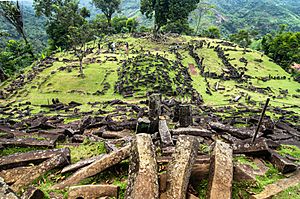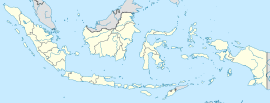Gunung Padang facts for kids

A view of Gunung Padang
|
|
| Location | Karyamukti, Campaka, Cianjur Regency, West Java, Indonesia |
|---|---|
| Coordinates | 6°59′38″S 107°03′23″E / 6.99389°S 107.05639°E |
| Type | Megalith |
| Site notes | |
| Discovered | 1890 |
| Archaeologists |
|
Gunung Padang is a very old and important site in West Java, Indonesia. It is known for its huge stone structures, called megaliths. These are large stones that were used to build things in ancient times. The site is located on a hill, about 30 kilometers (18 miles) southwest of Cianjur. It sits high up, around 885 meters (2,903 feet) above sea level.
The site covers a whole hill. It has five levels, like giant steps or terraces. These terraces are held up by stone walls. To reach the top, you climb about 370 steps made of a strong rock called andesite. These steps go up about 95 meters (311 feet). The whole area is covered with big, six-sided stone columns. These stones came from volcanoes. Local people, called the Sundanese people, believe this place is sacred. They think it was built by a legendary ruler, King Siliwangi, in just one night.
Gunung Padang has five man-made terraces. The first terrace is the lowest and largest. As you go higher, the terraces get smaller. They are arranged along a central line from northwest to southeast. These terraces were made by leveling out the ground. They filled in low spots to create flat surfaces. The edges of the terraces have walls made of volcanic stone columns. These columns are stacked flat or standing upright. A main stairway with 370 steps connects these terraces. It is about 110 meters (360 feet) long and quite steep.
Contents
Discovering Gunung Padang
People have known about Gunung Padang for a long time. A Dutch historian named Rogier Verbeek wrote about it in 1891. He learned about the site from a report by M. De Corte, who visited it in 1890. De Corte described four terraces with stone steps. He also noted flat stones and many upright stone columns. He thought some small mounds on the terraces might be graves.
Later, in 1914, another Dutch archaeologist, Nicolaas Johannes Krom, also mentioned the site. After that, Gunung Padang was not widely known for many years.
Rediscovery and Protection
In 1979, a group of local farmers rediscovered the site. This brought new attention to Gunung Padang. Many groups became interested, including archaeologists and local government. Throughout the 1980s, they worked together. They studied the site and helped to restore it.
In 1998, the Indonesian government declared Gunung Padang a heritage site. This meant it was important to protect it. In 2014, it was made a National Site Area. This covers a large area of about 29 hectares (71 acres). Sometimes, studies and digging at the site have been paused. This happens when new plans are being made for its protection.
How Old is Gunung Padang?
Scientists have different ideas about how old Gunung Padang is. Archaeologist Lutfi Yondri thinks it might have been built between the 2nd and 5th centuries CE. This would be during Indonesia's late prehistoric period. Another archaeologist, Harry Truman Simanjuntak, suggests it's newer. He thinks it might be from the 6th to 8th centuries CE. Small pieces of pottery found at the site were dated to around 45 BCE to 22 CE.
Different Ideas on Age
Some researchers, like geologist Danny Hilman Natawidjaja, have suggested a much older age. Based on some studies, he believes the site could be 9,000 to 20,000 years old. This would mean a very old and unknown advanced civilization built it. However, these very old dates have not been fully published or shared with other scientists. Also, the age estimates from these studies can vary a lot.
Other scientists have questioned these very old dates. For example, vulcanologist Sutikno Bronto thinks the carbon dating results might be wrong because of weathering. He believes the hill is actually part of an ancient volcano, not a man-made pyramid. Many Indonesian scientists have also raised concerns about the methods used for these older age estimates. They say that in archaeology, you usually find cultural items first. Then you date them and look for civilizations from that time. Some feel that for Gunung Padang, the age was suggested first, and then a civilization was imagined to fit it.
See also
- List of places with columnar jointed volcanics



